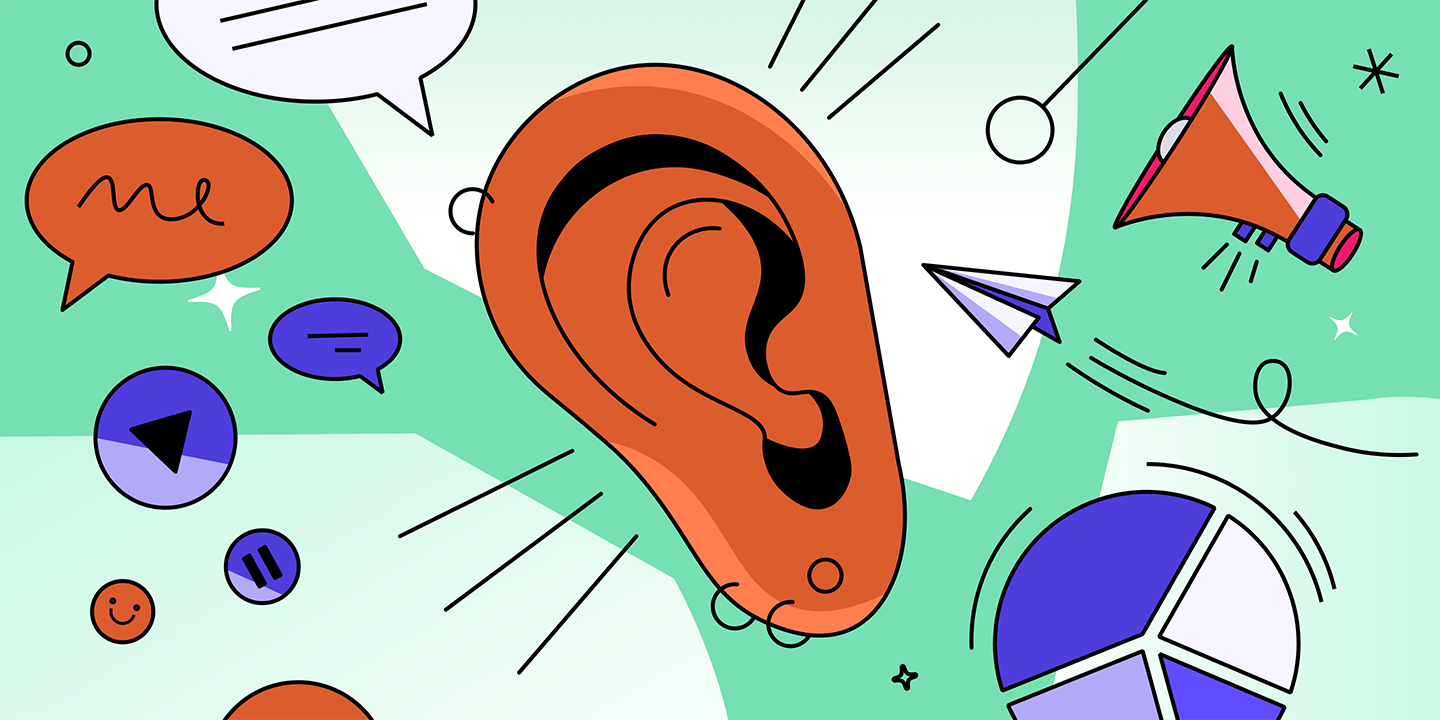Imagine this situation: Friday afternoon is coming up and you get an email from your CMO, asking why the internet is blowing up about your latest campaign, and not in a good way. You're about to head out of the office, but you check your social platforms and you see that all hell has broken loose.
There are two things that could have saved you: social listening and social monitoring.
Just like affect and effect, social media monitoring and social listening often mistakenly get lumped together. In reality, they have unique distinctions. See what they are and how both of these processes work:
- What is social listening?
- What is social monitoring?
- Social listening vs. social monitoring: key differences
- Why PR pros use social listening
- Why social monitoring matters to PR
- How to do social media listening with Prowly
- Combine social media monitoring and listening
Try Prowly's media monitoring free for 7 days
Start tracking sentiment, brand mentions, and keywords for free—no credit card required.
- Comprehensive monitoring: Track the web, social media, print, and broadcast mentions
- Transparent pricing: Plans start at $258/month
- All-in-one platform: Get everything you need in one tool for PR, incl. media database, outreach, reporting, and more
What is social media listening? A social media listening definition
Social listening is the process of actively tracking mentions of a certain brand or term on social media platforms and analyzing the context it appears in.
Social media listening not only captures your mentions, but also explains the intent behind them.
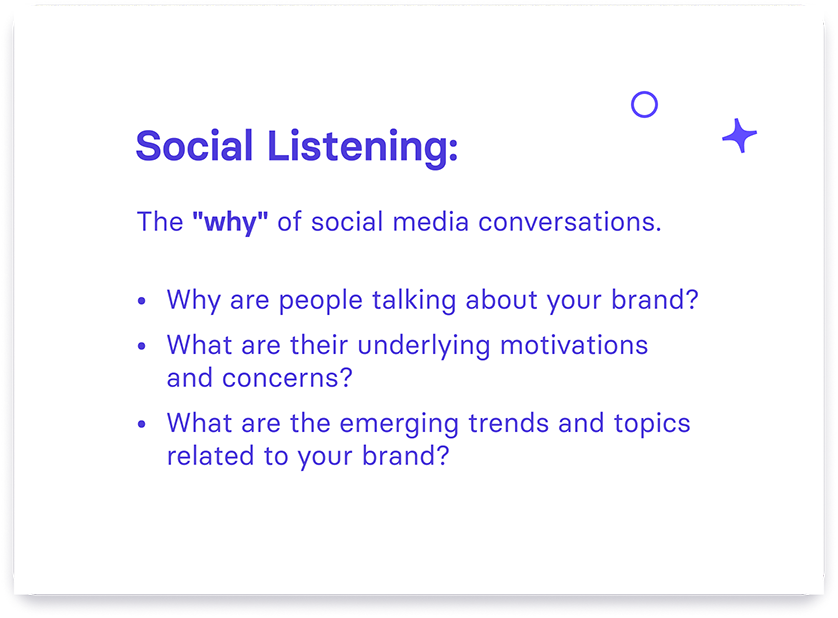
In this sense, social media listening is an umbrella term and social media monitoring is just one aspect of what it covers.
For example, you work at Pepsi and you recently launched a campaign. You monitor "Pepsi" as a keyword to see when, how and where people mention you. With social media listening tools, you can analyze the sentiment behind these mentions to see how your campaign was perceived by your target audience.
PRO TIP: Social media listening is part of any great digital PR strategy. Make sure you have the best tools for improving your online and social media presence.
What is social monitoring? A social media monitoring definition
Social monitoring is a subset of social media listening. It is the process of observing social media and keeping track of conversations and posts where a brand name or a term is mentioned.
With the use of social media monitoring tools, you can capture mentions of your brand across Facebook, X (Twitter), Instagram, and others in real time.
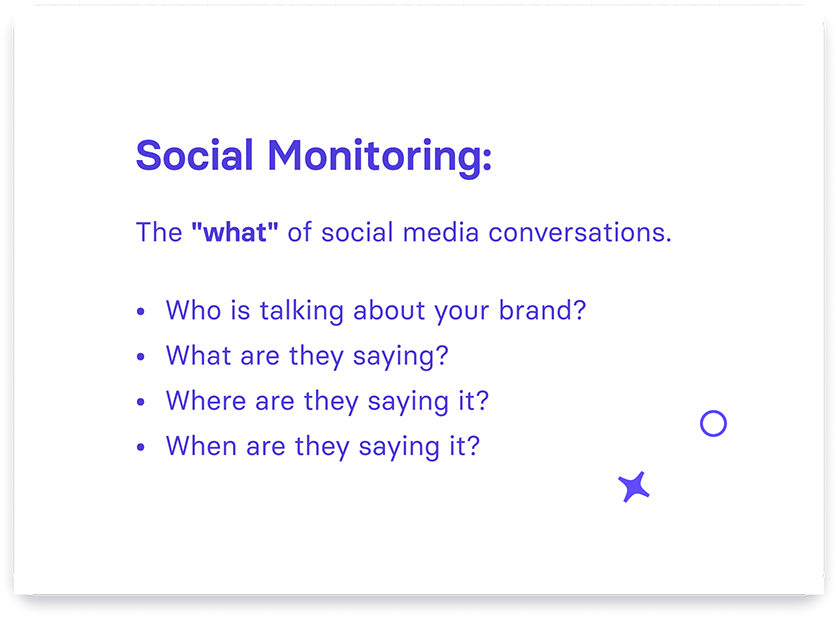
Think of it like customer support with superpowers. 🦸♀️
With social monitoring, your customer support reps can cover all of your social profiles from one dashboard, respond to customer comments, and engage with your audience.
For example, you work at Coke and you want to stay on top of which media outlets cover you so you can react immediately and build relationships with journalists and outlets. You turn on your social monitoring tool and get notified of new social mentions when they happen.
However, you can’t switch the tool over to autopilot and leave it at that - you need to be active and monitor the mentions as they roll in so you can react in time.
Ready to start with social listening and monitoring right away? Try out Prowly's Media Monitoring for 7 days free.
Social listening vs. social media monitoring: key differences
The two terms sound very similar but, in reality, there are noticeable differences. Whether you do social media management, PR, or general marketing, being familiar with the discrepancies can be useful.

The goal
1️⃣ For social listening, the ultimate goal is to get a deeper understanding of how the general public perceives you.
It not only tracks mentions but also analyzes them to understand the deeper context and topics of the conversations where people mention your brand and align those with your PR metrics.
2️⃣ Social media monitoring merely collects data with the aim of staying on top of mentions in real time. Branded keywords, hashtags, and relevant industry keywords are just some of the things that social monitoring tracks.
It requires a social media manager or PR professional to be active in monitoring these mentions as they come in and respond where needed.
The depth of research
1️⃣ Social listening goes deeper into research as you get more than just the mentions of your brand. With each mention on different social media channels, you get the context around it, sentiment analysis, and what it means for your brand presence.
2️⃣ Social media monitoring does not go beyond collecting mentions. As they come in from tools to monitor social media, your social media monitoring tool tells you which channels the mentions come from in real time so PR professionals can assess and respond to them directly.
The urgency
1️⃣ Social media monitoring is more urgent. You use social monitoring if you want to capture real-time insights and react immediately. It's the tool you use if you want to prevent social media crises before they snowball and become major issues. If negative mentions come in, social monitoring allows you to respond promptly.
2️⃣ On the other hand, social listening does not have any inherent urgency. As you monitor social media platforms over time and see how your target audience perceives you. This data does not need to be used instantly but instead serves as a basis for long-term PR and marketing strategies.
Learn how to use social monitoring for PR from The Complete Social Media Listening Guide for Public Relations, then check out this article on social media crisis management to fine-tune your strategy with a few practical tips.
Why PR pros use social listening
There are numerous advantages of media monitoring. Using a social listening tool for public relations can save time and money and make your social media marketing team more efficient.
Here are some practical reasons why social listening is a must:
- More chances to secure coverage. As notifications about new mentions keep coming in, you'll see every opportunity out there to get coverage and spread your brand message.
- Create meaningful relations. You don't have to search for journalists and outlets all the time. Spot the ones that talk about you and learn about their habits and past publications. Use this info to build a connection with them.
- Show the impact of your agency on a client's business. When you track and analyze mentions of a client's brand over time, you can show a clear connection between your PR work and the results they are seeing.
- Earn a seat at the table. As a PR or marketing agency or professional, you can use social listening to back up your new strategy with data before presenting it to your team.
Speaking of strategy, we have prepared a piece on creating one filled with tips and real-life examples in case you would like to delve a bit deeper.
Ready to start with social listening?
Why social monitoring matters to PR
Although social media listening is more comprehensive and in-depth, social media monitoring also has value for public relations:
- Real-time insights: you don't have to wait for weeks or months to get data from social media platforms and inform your social strategy.
- Having more time for key tasks: while a social media listening software collects mentions automatically 24/7, you can focus on more creative and managerial stuff.
- Managing a crisis: if social media posts are putting your brand at risk, you can put out the fires early.
- Identifying and engaging an audience: find out who talks about you on various social media platforms, respond to comments, answer questions, and build brand engagement in your audience.
- Monitoring your competitors: stay on top of competitors' mentions on your preferred social media platforms and see where you can improve and catch up.
- Identifying trends: guide your social media strategy by identifying new trends ahead of time instead of being the last one to join the game.
You can achieve all this by tracking social media mentions with Prowly.
👉 Tip: Read this full guide on social media reputation to get a complete picture of your PR strategy.
How to do social media listening with Prowly?
You can use Prowly for social media listening, and it's just as easy as writing an email. Here is how to get started.
Customizable social media monitoring and listening interface
Social listening provides access to real-time data.
However, the sheer volume of posts, reactions, and hashtags can be overwhelming. To react swiftly and make well-informed decisions, you need a centralized platform to manage all sources of information.
Dashboards are ideal for this purpose – you can customize them, focus on key metrics, and eliminate unnecessary distractions. With just a quick glance, you'll be in full control of your brand's narrative.
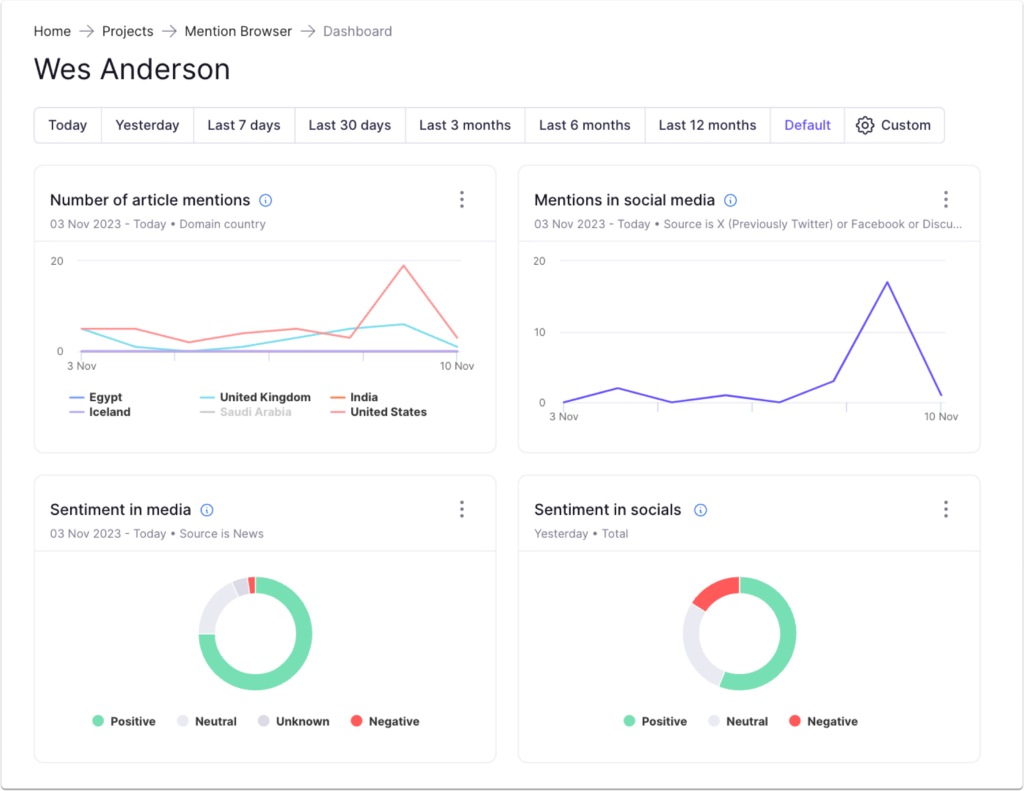
What can you use social listening dashboards for?
👉 comparing brand presence in articles vs. social media
👉 tracking mentions of a certain hashtag in social media
👉 tracking engagement around posts featuring a certain keyword, person, or brand
Social media sentiment analysis
Gain valuable insights about your brand by taking a look at the social media posts in isolation or get a big-picture look at how you are perceived as a brand based on posts from social media users.
Here you can see keyword monitoring being performed across different platforms such as Facebook and X (Twitter). By doing so, you can identify channels with potential crisis sources and conquer the challenges of sentiment analysis.
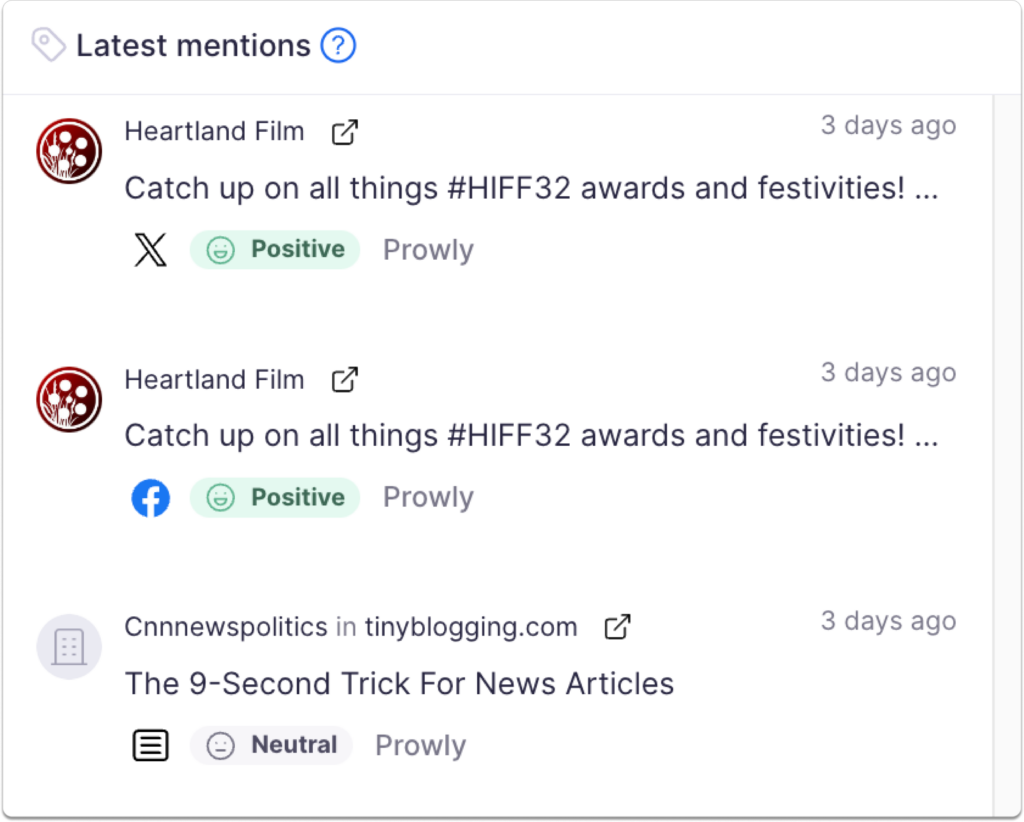
And since more and more users ditch Twitter, we prepared a list of its most popular alternatives, so you can stay in the know of the right channels to check.
Adding the results to your reports
The results of your social listening process can be shared with your manager, executive team, or clients. With one click, you can add the mentions you want, with sentiment analysis behind them, to your upcoming report.
Here you can add posts collected by social listening directly to your reports and cover the brand mentions that matter all in one place. And in case you're wondering what the cost of media monitoring is, we scanned the market and compared available tools in this guide.
Combine social media monitoring and listening
By combining social media monitoring and listening, you gain a holistic and comprehensive understanding of the brand you're taking care of in terms of PR.
👉 Social media listening enables you to track and measure the conversation surrounding the brand, industry, competitors, or influencers. This means you can evaluate sentiment and identify trends.
👉 On the other hand, social media monitoring allows you to have direct conversations with your stakeholders, including customers or potential customers, helping build relationships and fostering trust.
🤝 Combining social media monitoring and listening allows for capturing both quantitative data and qualitative insights into how people perceive your client's brand or industry.
This perfect mix can help inform more strategic PR decisions regarding messaging, campaigns, or brand positioning. And you can start doing it all with Prowly!
Wrapping up social media monitoring for PR purposes
The question is not who wins in the battle of social media monitoring vs social media listening. Both approaches are important for guiding your PR, marketing, and social media strategy.
The great news is that you don't have to choose between them if you have a tool that covers both. With Prowly, you can do listening and monitoring in one tool and get tons of amazing public relations features on top.
